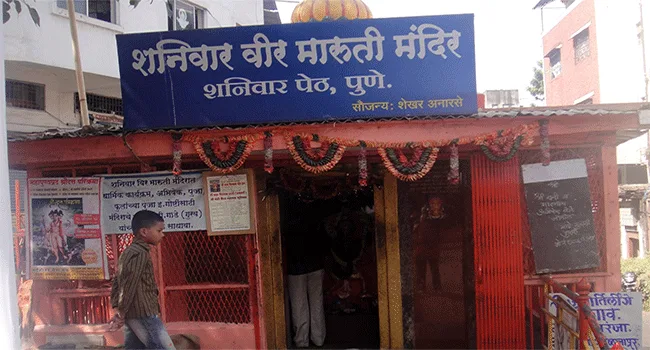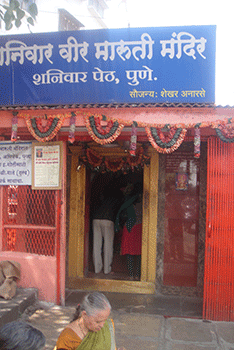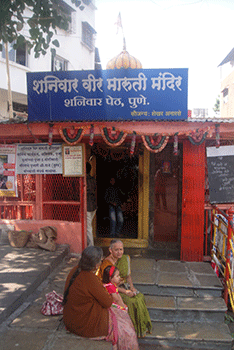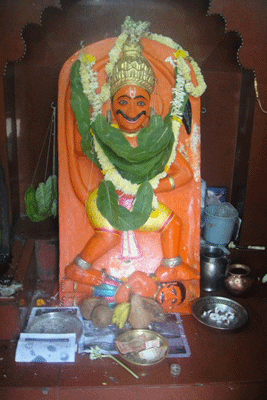
Maruti Mandirs in Pune
Untade Maruti mandir, Raste Peth, Pune
Dulya Maruti Mandir, Ganesh Peth, Pune
Lakheri Maruti mandir, Raste Peth, Pune
Pune
Today Pune is one of the best-known cities of India. It is also known as the cultural capital of Maharashtra. The origin of Pune starts with a settlement area which is presently known as Kasabe.
Kasabe of earlier days was destroyed completely and during Shivaji Maharaj's time, the city was recreated as Kasabe Pune. With Kasabe Ganapati temple and Lal Mahal for his mother, Pune once again became habitable and lively.
For more about Pune’s origin and its name click
Pune, Maruti, Ganesh and Mhasoda
 It was a custom to have a temple for Sri Maruti and/or Sri Ganesha at the border of each village. This practice in prevalence could be seen even in present-day Andhra, Karnakata, and Maharashtra. Apart from these two deities, a temple for Sri Mhasoba is also present in many villages of Maharashtra. All these temples were found on the borders of the village and were believed they bring good prosperity by removing all the obstacles and guarding the village.
It was a custom to have a temple for Sri Maruti and/or Sri Ganesha at the border of each village. This practice in prevalence could be seen even in present-day Andhra, Karnakata, and Maharashtra. Apart from these two deities, a temple for Sri Mhasoba is also present in many villages of Maharashtra. All these temples were found on the borders of the village and were believed they bring good prosperity by removing all the obstacles and guarding the village.
Pune is no exception to this practice. Each time a new peth is developed or the existing peth is modified, then to demarcate the boundary of the peth, these temples will come up.
Peths of Pune
During the rule of Shahu Raje, he gave the province of Pune to the Peshwas. During the Peshwas time, the development of Pune started. Real urbanization and development of Pune started once Bajirao I Peshwa settled down with Pune as his administrative headquarters. New areas were developed and were known as Peth. Peth is a business location. New peths were either named after the person who had developed or it was called by the name of a day of the week.
Many of the soldiers who had fought in the third war of Panipat were from Shaniwar Peth. Even now descendants of those ‘veers’ of Panipat are residing in this peth. There is a convention that the eldest son of the descendent of the ‘veer’ family worships and offers puja to veer Maruti of Shaniwar Peth. This puja is offered on the day of Holi.
To extend facilities to citizens some old peths were split, new areas were added and thus these peths were reorganized with new names. As narrated earlier the boundaries of the peths are marked by establishing a temple for Sri Maruti. It is one of the reasons we see many temples for Maruti in Pune.
Shaniwar Peth
When Bajirao I made Pune his headquarters, the town already had six ‘Peths’ namely, Kasba, Shaniwar, Raviwar, Somwar, Mangalwar, and Budhwar. Murtazabad which was in existence from the early 17th century was converted to Shaniwar Peth. Many of the soldiers who had fought in the third war of Panipat were stationed here. This Shaniwar peth is fairly large.
Par shrine and Veera Maruti Mandir
 This Veera Maruti temple is listed as a Heritage site at S No 77 in the Heritage List published by Pune Municipal Corporation under the Grade II list.
This Veera Maruti temple is listed as a Heritage site at S No 77 in the Heritage List published by Pune Municipal Corporation under the Grade II list.
While there are many Maruti mandirs in Pune, there is only one Veera Maruti in Pune. This is located at the junction of Omkarashwar Path, Namdeo Raut Peth, and Niranjan Mahadev Peth in Shaniwar Peth. It is interesting to note that the location of the temple is more or less the middle point of Shaniwar Peth.
As mentioned earlier it was a practice to plant a boundary stone for the peth and also establish a temple for Maruti at the boundary. The boundary stone is known as ‘par’ here in Pune. If a symbol of any deity is embossed on the boundary stone, it is worshipped and such par is known as a ‘par shrine’. Such ‘par’ is placed under a tree. So far Pune is concerned such ‘par’ is left untouched even though other developments in the area are taking place. Such preserved 'par shrines' tell us and remind us of the old history of Pune and its contribution. Normally alongside the par the temple for Maruti is also built.
This [veer] Maruti Mandir is one such mandir along the par shrine in Shanivar Peth. Although it is in one of the major junctions, the serenity had been preserved. This temple is connected with commemorating the Veer Marathas who fought and sacrificed their life in Panipat.
To know more Pune connection to third battle of Panipat please click
Many of the soldiers who had fought in the third war of Panipat were from Shaniwar Peth. Even now descendants of those ‘veers’ of Panipat are residing in this peth. There is a convention that the eldest son of the descendent of the ‘veer’ family worships and offers puja to veer Maruti of Shaniwar Peth. This puja is offered on the day of Holi. It is to seek the blessings from their ancestors who had sacrificed their lives for the country. Apart from this during the Hanumath Jayanti celebration which is celebrated for days, these veers are venerated.
 The temple is south-facing and there is a huge angan in front of the Mandir. Huge peepal tree under which there is a Par shrine. When I had darshan [2014] there was no mandap for the par shrine, I was given to understand that in the recent past a marble, mandap had been made for the par shrine. Devotees can have a darshan of the Lord from the angan itself. Day through we can see devotees reciting Bhimrupi Maruti sloka of Sri Samarth Ramdas. The pleasant environment at the mandir brings peace of mind to the devotee.
The temple is south-facing and there is a huge angan in front of the Mandir. Huge peepal tree under which there is a Par shrine. When I had darshan [2014] there was no mandap for the par shrine, I was given to understand that in the recent past a marble, mandap had been made for the par shrine. Devotees can have a darshan of the Lord from the angan itself. Day through we can see devotees reciting Bhimrupi Maruti sloka of Sri Samarth Ramdas. The pleasant environment at the mandir brings peace of mind to the devotee.
Veer Maruti
The moortham of the Lord is about four feet in height and facing south is placed on a raised platform.
Lord is in standing posture. Both Lotus feet of the Lord are adorned with hollow anklets. Under His feet is a demon trampled. The feet of the demon are under His right foot and the head of the demon is under His left foot. The fear, anxiety, and trepidation of the demon are fully seen in the facial expression of the demon. Lord is wearing a dhoti in kacham style. He is wearing ornaments adorning His bosom. Both hands are adorned with keyuram on the arm, the bracelet on the forearm, and the anklet on the wrist. His left hand is seen resting near his navel. His right hand is showing mushti mudra indicating readiness to combat with the enemy. There is a necklace around His neck and a mala. The tail of the Lord is raised above His head and ends near the left shoulder. Lord is wearing a crown over His head. In His huge ears, He is wearing a kundal. Lord has big moustaches. Look at the great captivating eyes of the Lord. Mesmerising is a simple word to describe. Although the Lord is showing Mushti Mudra the enemy when meets His eye is bound to surrender.
Location of the temple: "Shaniwar Veer Maruti Mandir, New Nana Peth, Pune "
Experience
Lord of this kshatra had bestowed confidence and fearlessness to His devotees and enabled them to bravely face adversity. darshan of this Lord is sure to demolish the concealed anger, irritation, or aggravation out of our system for sure.
SRI HANUMAN THINKS DIFFERENTLY, THINKS FAST
THINKS AHEAD AND ACTS FOR SURE
Ed [July 2023]
Updates: [Jan 2025]
